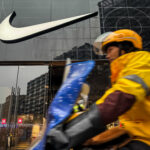
A college student’s fatal Uber mixup has renewed the clamor for rideshare-app safety.
Samantha Josephson, a 21-year-old University of South Carolina student from New Jersey, climbed into a black four-door Chevrolet Impala she thought was her Uber after a night out with friends in late March, police said. Turkey hunters later found her body in a wooded area with “multiple sharp force injuries.” Authorities charged Nathaniel Rowland, 24, with her alleged kidnapping and murder.
“We believe that she simply mistakenly got into this particular car thinking it was an Uber ride,” the Columbia police chief, Skip Holbrook, said in a news conference. “She opened the door and got into it, and departed with the suspect driving.”
Seth Rose and Micah Caskey introduced a ’Samantha L. Josephson Ridesharing Safety Act’ bill this week requiring rideshare drivers to display illuminated, company-provided signage.
The young woman’s death has already prompted action to strengthen ridesharing safety. South Carolina State Reps. Seth Rose and Micah Caskey, for example, introduced a “Samantha L. Josephson Ridesharing Safety Act” bill this week requiring rideshare drivers to display illuminated, company-provided signage.
University of South Carolina president Harris Pastides, meanwhile, asked community members to pledge that they would ensure their rideshare vehicle and driver details aligned with information from the app, and make a habit of asking the driver, “What’s my name?” before entering the vehicle. A Change.org petition calling on Uber and Lyft LYFT, -10.10% to institute QR codes for verification purposes had drawn more than 66,000 backers by Friday afternoon.
And Josephson’s father, Seymour Josephson, urged riders during a vigil for his daughter to seek out safety in numbers. “If there is somebody else in that car, there is actually a chance,” he reportedly said.
An Uber spokeswoman, in a statement sent to MarketWatch, said the company had been “working with local law enforcement to educate the public about how to avoid fake rideshare drivers” since 2017.
The company in coming weeks plans to launch a social-media awareness campaign to “Check Your Ride” — in other words, make sure the car’s license plate, make and model, as well as the driver, match up with what the app says. It will also buy college-paper ads to promote a “Check Your Ride” PSA, promote its in-app safety center to U.S. riders, and remind riders during pickup of the “Check Your Ride” steps through push notifications.
University of South Carolina president Harris Pastides asked ridesharers to pledge to make a habit of asking the driver, ‘What’s my name?’ before entering the vehicle.
“Everyone at Uber is devastated to hear about this unspeakable crime, and our hearts are with Samantha Josephson’s family and loved ones,” the Uber spokeswoman said. “We spoke with the University of South Carolina President and will be partnering with the university to raise awareness on college campuses nationwide about this incredibly important issue.”
Lyft, the company’s main competitor, did not respond to a request for comment about the recent heightened attention to rideshare safety.
Josephson’s death was the latest worse-case rideshare scenario to make headlines — even just recently. An Uber driver arrested for allegedly raping a female passenger appeared for his arraignment in a Boston court Monday. A Brooklyn woman told PIX11 News this week her Uber driver had physically assaulted her and hurled a homophobic slur after she asked him to take a different route home. An ex-Lyft driver in Georgia convicted of raping an intoxicated female passenger in 2016 received a 35-year prison sentence last month.
And Josephson’s alleged assailant isn’t the only bad actor to have been mistaken for a rideshare professional: Police charged an Alabama man with kidnapping in March after finding an unconscious college student in the back seat of his car. He had posed as an Uber driver, authorities said, and used a fake Uber sign he purchased online.
An Uber driver arrested for allegedly raping a female passenger appeared for his arraignment in a Boston court Monday. A Brooklyn woman told PIX11 News this week her Uber driver had physically assaulted her.
While public data on these incidents remains scant, an April 2018 review by CNN of law-enforcement records found that at least 103 U.S. Uber drivers and 18 Lyft drivers had been accused of sexual assault or abuse of riders over the previous four years. Who’s Driving You?, a campaign by the Taxicab, Limousine & Paratransit Association, tallied “four previously unreported deaths, 92 sexual assaults and 12 physical assaults” during the summer of 2017, the majority of which involved Uber drivers.
Harry Campbell, the founder of The Rideshare Guy and author of The Rideshare Guide who drives for Uber and Lyft, said the biggest mistake he sees passengers make is treating the pickup process “very casually.” He recalled some passengers forgetting whether they’d hailed an Uber or Lyft, and others getting into the wrong car by accident.
“It’s sort of funny when it happens in the moment,” Campbell told MarketWatch. “I could just see how things could go wrong if passengers got into the car of someone who was trying to take advantage of that situation.”
The simplest way for rideshare passengers to stay safe is by double-checking their driver’s license plate against the app, Campbell said. “Verifying the license plate is 100% going to work,” he said. “That’s the foolproof way.” But he admits many passengers may not take that step. Additional precautions include asking the driver for his or her name, he said, and verifying the car’s make and model.
Police charged an Alabama man with kidnapping in March after finding an unconscious college student in the back seat of his car. He had posed as an Uber driver.
Uber and Lyft could also take some small steps in “nudging the passenger in the direction of checking for the license plate,” he suggested. That might mean giving riders a stronger nudge in the form of a push notification to verify their driver’s license plate during pickup, or having drivers remind passengers to ask for their names when they enter the car.
Uber offers its own list of rider safety tips, including waiting indoors until the driver has arrived, sitting in the back seat when traveling alone, and sharing trip details with friends or family through the app so they can track the trip and view an ETA. The company has announced multiple new safety features in the past year, including an emergency 911 button, 911 integration and a dedicated place for safety information. Uber also said it would re-run criminal and motor-vehicle checks on an annual basis, and monitor new criminal offense data. Lyft, for its part, offers a 24/7 “critical response line.”
Female-focused rideshare companies have also sprung up in response to the industry’s safety concerns. The Southern California-based See Jane Go, which shuttered in January of 2018 due to a lack of funding, catered to female riders with female drivers.
And the Boston-based company Safr, which came under legal scrutiny for its initial all-female business idea, called Chariot for Women, allows both riders and drivers to choose the preferred gender of their driver. The service says it’s “focused on the safety and empowerment of women.” It includes an “SOS” button that allows riders to contact 911, Safr or a pre-determined emergency contact; color-matching for both the rider and driver to verify upon pickup; and a “command center” that tracks rides in real-time. (Safr did not respond to a request for comment.)
While Campbell said he would be surprised to see Uber and Lyft move in that gender-specific direction, he suggested there could be a big market for such services — based on conversations he’d had with women on both the passenger and driver sides.
“Female drivers tell me all the time that when they get a female passenger it makes them feel very reassured, especially late at night,” he said. “Giving riders that option, I think, could be really beneficial. … A lot of the passengers might even pay more for it too.”
Get a daily roundup of the top reads in personal finance delivered to your inbox. Subscribe to MarketWatch’s free Personal Finance Daily newsletter. Sign up here.












